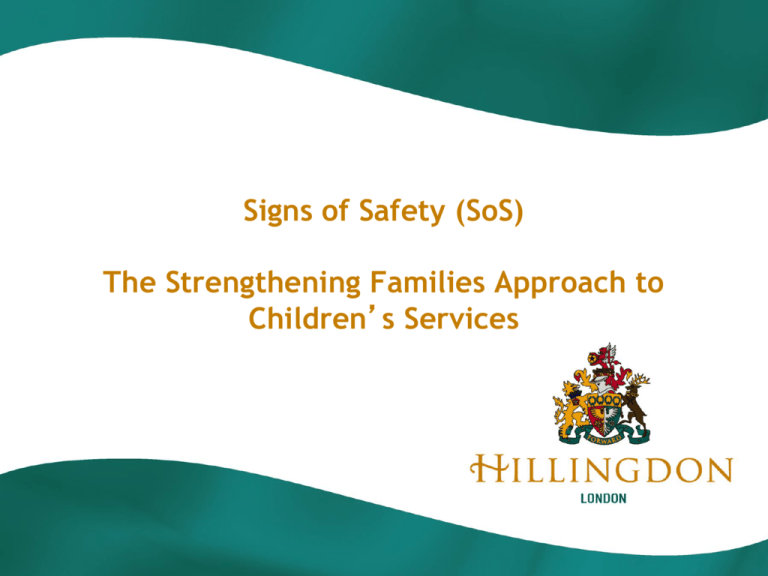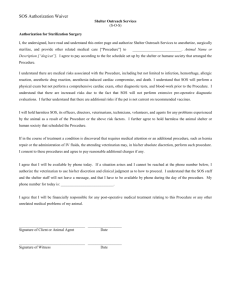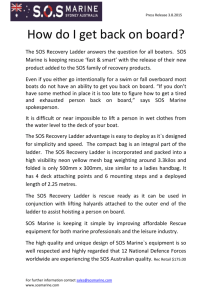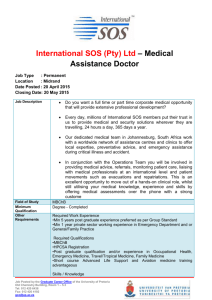Signs of Safety - London Borough of Hillingdon
advertisement

Signs of Safety (SoS) The Strengthening Families Approach to Children’s Services What this presentation will cover • • • • • • An explanation of the Signs of Safety model Why are we doing it What we want to do How will it be delivered How will it be resourced How long will it take [timescale] What is SoS 1.. • It is a systemic way of working with families which identifies strengths, reduces risks to children and enables solutions to family problems to be found as early as possible to prevent family breakdown and family dysfunction • The principles and practice of the SoS have been formulated as a response to a number of the SYSTEMIC challenges identified in child and family welfare many of which were critiqued in the Munro review, with its emphasis on early help being given to families and prevention of high risk to children. • SoS requires COLLABORATIVE work across all agencies and professional disciplines and encourages family participation through listening to the contributions of the child, the parents, and all the relevant personal and professional links to a family’s network. • Its approach to Managing Risk and Safety encourages transparency and rigour in professional judgement when identifying risks and strengths and provides a coherent framework for planning future interventions. • Most significantly, it demands the type of critical and reflective thinking which which cannot be provided in traditionally linear supervision formats. What is SoS 2.. • The Signs of Safety model can be seen as a practical framework aimed at equipping social workers and other professionals with techniques and skills to create co-operative relationships with children and families who are involved in the child protection, from the early stages [pre-statutory] right through to the specialist and acute levels of need .[Hillingdon’s core operating model] • The model draws on the language and tenets of brief solution focused therapy. Solution focused therapy is a “client centred approach” developed mainly by Steve de Shazer et al (1985). It operates on the premise that even in the face of difficulty, “the client” is already in possession of resources which if supported, can be consistently mobilised by the client to elicit desirable changes. • Contrary to traditional approaches to risks which tend to focus on the deficits of a client’s circumstances, the Signs of Safety model (SoS) looks at the client’s existing strengths and potential safety capacity for children to thrive within their family context. What is SoS 3.. • This is achieved through the use of methods of questioning which promote reflective, forward –thinking, using a nonblaming, respectful and co-operative stance. • The compassionate philosophies of this approach have been reportedly conducive to empowering both the client, social worker and professionals working with the family. • The questions used in sessions are framed in positive psychology which serves to reframe the way the client views their situation and simultaneously expands the social worker’s perspectives on the problem. What is SoS 4.. • As all parties become agents in the change process SoS has been effective in helping with case impasse and in alleviating social worker-client impasses and conflicts and promotes increased levels of engagement. • SoS is the one of the first models to implement robust principles around partnership and family participation from early intervention to the intake of referrals and all the way through to case closure ensuring that focus is maintained on positive outcomes, especially for children. Why Signs of safety (SoS) in Hillingdon • Hillingdon is committed to its transformation agenda, and to re-position the children’s service at the centre of cutting edge social work research and practice in line with the recommendations of the Munro review. • The Signs of Safety-Strengthening Families model (SoS) has attracted significant local, regional and international recognition in Children's services as an outcome–focused, strengths-based model with humanist principles underpinned by research and evidence-based practice. Why SoS – Evidence from Munro - 1 • ‘Children and young people are a key source of information about their lives and the impact any problems are having on them in the specific culture and values of their family. It is therefore puzzling that the evidence shows that children are not being adequately included in child protection work’ • Munro’s systems analysis sheds light on how the perils of maintaining a culture of over-bureaucracy and compliance have necessitated a mandatory shift to a culture which must develop professional expertise to improve interventions. • This is in order to ensure that social work practice is focused on child safety, empowerment of families, effective multi agency working and measurable child focused outcomes. Why SoS – Evidence from Munro - 2 • The consequences of excessively target driven and output oriented work is most succinctly described in Munro’s view that: • ‘Social workers are often reliant on one person for case reflection, practice knowledge and managerial skill set. Decision-making on cases is frequently the responsibility of that manager, despite the manager often not knowing the child and family very well, if at all. This leaves the social worker in an awkward predicament, holding case responsibility, but with little autonomy for decision-making. • Flexibility in accessing other reflective opportunities to think differently about what is happening in a family and what might help, can be very limited. A common experience amongst social workers is that the few supervision opportunities are dominated by a managerial need to focus on performance, for example, throughput, case closure, adhering to timescales and completion of written records. This leaves little time for thoughtful consideration of what is happening in the lives of children and their families.’ Why SoS – OFSTED - 1 • Two key recommendations from the Munro report in regards to OFSTED Inspections are: • The inspection framework should examine the effectiveness of the contributions of all local services, including health, education, police, probation and the justice system to the protection of children (Recommendation 2). • The new inspection framework should examine the child’s journey from needing to receiving help, explore how the rights, wishes, feelings and experiences of children and young people inform and shape the provision of services, and look at the effectiveness of the help provided to children, young people and their families (Recommendation 3). Why SoS – OFSTED 2.. • Inspections should focus on the child’s experience and outcomes for the child across the whole of the child’s journey, not just from the point of referral to children’s social care. Munroe’s view is that inspection should assess: • the effectiveness and impact of the help provided, or not provided, • as well as the quality of initial identification and assessment OFSTED - What will be Inspected The critical areas to be inspected are: a) the effectiveness of multi agency arrangements for the identification of children at risk of harm. b) the provision of early help to resolve those concerns c) the effectiveness of the local authority and partnership system that protects these children if the risk remains or intensifies. How does the SoS model work in Practice? • Turnell and Edward point out that the preoccupation with risk permeates all aspects of Child protection work and compromises the attention which needs to be paid to developing a safety plan for children to provide them with safety in their present and future. • Therefore, SoS advocates that alongside risk assessments, the discovery of the sources of safety in each family needs to be explored from the onset of social work or early professional intervention. • The first stage required from the practitioner is that they obtain the perspective of the family about their perceived competencies and goals to ensure the safety of the child(ren). • Following this, the practitioner then explicitly states the perspectives of the statutory agency, and early intervention services and clarifies its own safety goals for the child. Key Elements of SoS 1.. Significance of hearing the competing Narratives - In order for the risk and safety assessment to be undertaken, the practitioner needs to ensure that they elicit the stories from the child(ren) and all family members and identify the stance that the parent has adopted in relation to any child welfare or safeguarding concerns. Exploring Exceptions to the Rule - Exceptions to the rule is an idea derived from the solution focused repertoire of Steve de Shazer. It encourages the parent to identify instances wherein abuse or neglect could have happened but did not. Key Elements of SoS 2.. Expanding the context of the family picture - SoS requires the practitioner to elicit the strengths and resources within the family by asking questions about how family members perceive each other and hold each other in mind. This approach is said to yield valuable information about aspects of the family which can be developed as part of the safety plan designed to alleviate the abusive interactions between the child and their parents. GOALS and OBJECTIVES - Turnell and Edwards have pointed out that most pertinent to the SoS model, is the robust manner in which it is able to facilitate concrete goals from the family and equally clear goals from the local authority and other agencies. Use of the SoS model explicitly asks the family and the professional network questions which will elicit clarity and a level of mutuality in understanding what needs to happen to resolve the abuse, or meet their needs . Key Elements of SoS Scaling as a tool to monitor progress and cooperation – In order to obtain specificity and detail in Child welfare or child safeguarding, scaling questions on a continuum from risk to safety can be asked to find out how the parent and family network are rating their progress towards the desired outcomes. Key Elements of SoS Motivation & Capacity for Change - As the SoS approach uses methods to gain active participation from the parent, the plan will contain ideas which the parent will often feel comfortable with working towards (given that they have either been able to achieve it before) or they may feel confident in their ability to learn with agency support. Assessment & Planning - Signs of Safety require practitioners to critically review their perceived indicators of risk alongside the signs of safety within the family. The assessment then calls for all the practitioner and core professional network to exercise their professional judgement by allocating a child safety rating to each area of risk using the safety scale. It is worth noting that the SoS model is used as an information gathering process which can offer practitioners a rigorous framework to qualify their professional judgement whenever asked to evidence their decision-making process. As parents are required to witness and participate in this information gathering process particularly in CP conferences, the model has even been used in cases where decisions have made for children to be adopted. Proposals for change – Implementing SoS • All Management Structures to be informed and trained about the use and application of the model – including the Children’s Pathway Board, The Hillingdon Safeguarding Children’s Board, The LA’s Divisional Managers Group… These are currently being scheduled. • As SoS is a whole systems approach, it will require the Senior Managers across the partner agencies to be trained and familiarised with the principles of the model. The first of the proposed training dates took place on 22 March 2013. [this included the designated safeguarding leads within the agencies, e.g. Designated Teachers, Nurses etc]. • The establishment of a project steering group to ensure the embedding of the model across all agencies. • The training of individual champions across the partnerships, to facilitate trainers in each agency to train their staff in the SoS model, so that the model is embedded across all levels of the partnership agencies • The training of all Case Conference chairs to facilitate a Strengthening families model in Case Conferences. Training Plan for SoS –Stages Stage 1 • Senior Managers, frontline managers, IRO’s, CAF co-ordinator & LSCB training leads will be required to make up the first training cohort to support managers to understand how use of the model will facilitate the change in practice culture to resonate with the organisation’s mission to create a learning culture to improve outcomes for children. Stage 2 Steering groups will be required to review how the thinking and practice of the Signs of Safety model may best be embedded across all aspects of the organisation to address the following: • Identify any required changes to areas of the organisation to support the use of the model • Review the feedback from staff, and other professionals and families • Ensure that communication loops are kept fluid enough to achieve effective communication about the model across all levels of staff • Review any operational or logistical challenges which may be impacting on the progress of the model’s implementation & assist with administrative issues especially regarding locations and equipment. • Provide feedback to senior management Training Plan for SoS –Stages Stage 3 • This stage would be required to factor in all administrative changes which would need to be implemented to ensure that all SoS forms are uploaded onto ICT or tailor made through Liquid Logic for the Protocol system. This will help with the mergence of auditing tools, supervision and all case management forms, report and conference formats, ensuring a proper focus on outcomes for children rather processes. Stage 4 • Action Learning sets would need to be considered to provide managers with a reflective forum to offer peer support and advice around any experienced challenges around use of the model. The learning sets would also provide a forum for reviewing any further areas within the strategic and operational planning of the service which may benefit from use of the SoS of framework. Feedback around the progress of these learning sets would need to be provided to senior management. These sessions would be required to be rolled out over an 8- 12 week period and will be attended by 8-10 practitioners. Training Plan for SoS –Stages Stage 5 • As part to the PADA process the Practice Development lead and advanced practitioners will jointly attend CP conferences, home visits and core group meetings to observe the practice of individual practitioners, and their application and use of the Signs of Safety model. • An Evaluation of the model to be conducted jointly with partner agencies 6 months after commencement and annually months there afterwards through peer review systems already established within the LSCB [e.g. multi-agency case auditing] The Implementation of Child Protection Case Conferences • As Child Protection Conferences will require the chair to be more robust in including the family in order to ensure that plans are outcome focussed and a shared understanding is established for change. Bespoke, specific training will be delivered for IROs • All key lead agency staff across the Safeguarding Children’s Board will be trained over the next 5-6 months – April to September 2013 • All IROs / Child Protection Case Conference Chairs are being trained within the 6 months commencing April 2013 • A pilot phase will be initiated in September/October 2013 with an evaluation scheduled to start in December 2013 • Full scale implementation of conferences to then begin with evaluation feedback from January 2014 How will the Implementation be Resourced and Funded ? • It is proposed that the implementation of the SoS model will be funded through the Government awarded Grant given to every LSCB in each Local Authority [including Hillingdon] for the implementation of Munro.[The Independent Chairman has agreed this in principle, but it will be formally presented to the main board meeting in March 2013]. • The costs for implementation will include the training and licensing of professionals [e.g. the LSCB Training and Development Manager] making the case conference rooms more child focussed and conducive to families actively participating in the conference, any minor changes to existing forms on ICS, evaluation of the model at 3 months and 12 months. SoS in the UK, and the London Region • There are several LAs currently implementing the SoS model both within and outside of London including Brent, Barnet, Tower Hamlets, Southwark, Wandsworth, Swansea and Swindon. • The Strengthening Families model in Child Protection Conferences is currently being implemented in Oxford, West Berkshire, Gateshead and Westminster, to name a few. • Due to the Munro Review and how well SoS addresses her concerns about the failures of the existing system, the London Safeguarding Children Board has commissioned research into the effectiveness of the model across the boroughs that are using various aspects of the model. Hillingdon will participate, and take note of the lessons learned from the research.





